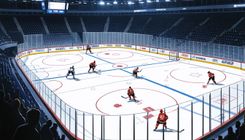NHLs New Collective Bargaining Agreement Brings Changes for Development of Young Prospects

The current NHL collective bargaining agreement (CBA) is set to expire in September 2026, a timeline that may evoke unease among those familiar with the sport's history of labor disputes. However, in a surprising development, NHL owners and the NHL Players Association reached an agreement on the framework of the new deal this summer. While the complete Memorandum of Understanding has yet to be publicly released, NHL insider Frank Seravalli has highlighted a significant alteration that promises to reshape player development in the league. Under the new CBA, each NHL team will be permitted to assign one 19-year-old prospect to their American Hockey League (AHL) affiliate each season. This policy, while seemingly affecting only a small number of players, could have profound implications for the development trajectory of young NHL prospects.
Historically, players drafted from the Canadian Hockey League (CHL), including leagues such as the Ontario Hockey League (OHL), Western Hockey League (WHL), or Quebec Major Junior Hockey League (QMJHL), could not transition to the AHL or ECHL until they turned 20 or completed four seasons in the CHL. However, players drafted from other junior leagues and later joining a CHL team were exempt from these stipulations. With the introduction of the new CBA, which will take effect starting in the 2026-2027 season, the first group impacted will include players born in 2007. For instance, Vancouver Canucks prospect Braeden Cootes, who turns 19 in February of 2026, could be assigned to the Abbotsford Canucks that fall if the team's management deems that the WHL is no longer the ideal environment for his development.
The regulation's age-based criteria, rather than being tied to the draft year, may allow newly drafted CHL players who reach 19 in the fall following their draft to bypass a return to junior hockey. For example, Ryan Roobroeck, a top prospect eligible for the 2026 draft with a September 2007 birthday, could potentially sign his entry-level contract and join his NHL team's development camp, thus enabling his assignment to the AHL over a return to the Niagara IceDogs of the OHL. This presents CHL-affiliated prospects with a new avenue for development—an option that has been long overdue. A decade ago, discussions surrounding similar developmental pathways gained traction, particularly for players like Dylan Strome, who was too advanced for junior hockey yet not ready for the NHL, leading to questions about his developmental trajectory. With the opportunity to transition to the AHL earlier, players unlikely to benefit from additional junior seasons may now find a more suitable environment to hone their skills effectively.
Recent years have illustrated the significance of providing alternate pathways to these players. Cole Perfetti benefited from playing for the Manitoba Moose when the pandemic halted his junior season with the OHL's Saginaw Spirit in 2021. Likewise, Shane Wright received an exemption allowing him to skate with the AHL's Coachella Valley Firebirds during the 2023-2024 season, having played in the OHL since the age of 15. In his situation, the pandemic's cancellation of the 2020-2021 season would have qualified him, making his near-birthday cut-off an impacting factor. Such instances demonstrate how play at the AHL level can enrich player development over returning to the OHL or facing the risk of sitting out an entire season. Insiders have specified that the clause will allow for the assignment of 'one player per organization per season,' implying that teams will not have the flexibility to cycle multiple 19-year-olds in and out of the AHL while maintaining another prospect on their roster.
The new rule may provide vital benefits for NHL teams that prefer keeping promising prospects closer to their organizational structures. This direct oversight enhances the ability to monitor player performance and facilitate player development in collaboration with the NHL squad. However, this shift poses challenges for CHL teams, who are likely to resist losing their top talent to AHL assignments. The restriction of one assigned player per NHL team was likely influenced by the CHL's interests, given the potential loss of their high-impact players. Furthermore, while NHL teams can only designate one player each season, there are no stated limitations on the number of players an NHL franchise can recruit from individual CHL teams, intensifying the stakes.
The advent of this policy may represent a setback for the CHL, compounding issues stemming from existing regulations regarding players transitioning to the NCAA. Should U.S. President Donald Trump's recent executive order on NIL (name, image, likeness) regulations impact those connections, it could slightly benefit CHL players navigating this new framework. For top players, the option to enter professional hockey a year earlier could prove advantageous, allowing them to challenge their weaknesses and build on their strengths at the pro level. One notable example of a team that could see the advantages of these changes, albeit begrudgingly acknowledged, is the OHL's London Knights—a perennial powerhouse known for their consistent championship success. However, success often breeds a lack of adversity. Thus, there are concerns that players may benefit from confronting more significant challenges in the AHL, promoting growth that could be stunted by prolonged success at the junior level.
An additional aspect arises from the perspectives of player agents and organizations. As prospect writer Scott Wheeler highlighted, multiple agents expressed that numerous prospects might prefer the CHL-to-AHL route, especially given the potential signing bonuses associated with entry-level contracts compared to pursuing NCAA opportunities. Furthermore, a CHL general manager underscored that under certain terms of the CBA, players might attain arbitration rights a year earlier by opting for the AHL pathway. The prospect of acquiring arbitration rights sooner represents a notable benefit for young players, potentially outweighing the advantages of entering professional hockey a year ahead. The signing bonuses and guaranteed salaries available in the AHL create an attractive alternative to returning to school—an option that many players are keen to avoid.









